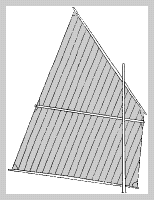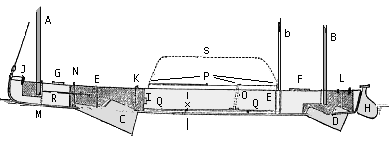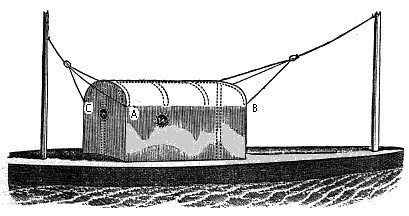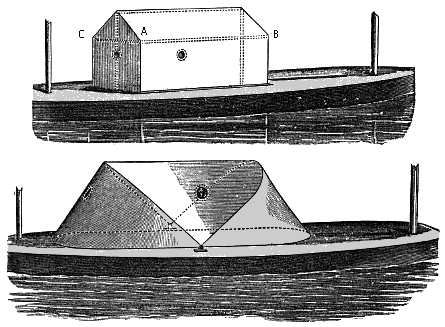
A CANOE is not big enough to live on board of for any length of time, nor would she be if she were half as big again every way, so the right thing is to have the canoe, so light and small that she can be landed with ease, and stowed in a boat-house, while her owner goes ashore.
I think it is usually best when possible to put up at hotels, not to camp or sleep on board, as the better you feed and sleep the better you will work. However, it is very important to be able to spend a night on board without hardship, and so to render oneself independent of all that anxiety as to finding quarters for the night, which is apt to spoil the best hours of the evening; so by all means let there be "cabin" accommodation on board. Some hardy canoeists are content to cover the well with the hatches, etc., and so go to sleep "anyhow." This is not quite as miserable as it sounds, and if by ill luck one need sleep on board in such a wind that no kind of tent can be safely erected, it will be the only plan possible. A square of oilskin, some 2 feet across should cover the opening of the well. This will also be handy to keep out rain if the canoe is left afloat for a time.But for comfort, something more than a cover for lying down under is required. One must be able to spend the evening in shelter, in an easy position, with means of cooking, reading, etc. By erecting a little tent over the well, these objects can be secured; and, with a little ingenuity, the interior of the canoe may be made a very snug little cabin indeed. Thus, so long as there is a bit of beach to haul up on, or a reasonably quiet anchorage, the canoeist is independent of all men and all things. Although the day's journey may end in the darkness, perhaps of a cold rainy night, in a few minutes the tent is up, the lamp is lighted, and the preparations for tea are under way. When this is disposed of and the duty of washing-up performed, the interval till bed-time may be filled by writing up the log, or letters to friends at home; the course for the next day may be studied, the piece of chart required may be got out and any bearings, etc., noted. This, with reading, and perhaps working up sketches taken during the day, stropping a block or two, or any other little jobs, will bring even a longish evening to an end; after which, with a farewell glance at the sky, the barometer and the riding light, the crew may turn in.
Sound sleep will be promoted by well securing all gear, especially the rudder, against rattling and shaking about. If afloat, see the boat is securely anchored, and if the weather is threatening and the berth an exposed one, take in a reef or two overnight and see everything clear for getting under way in a hurry. Even when I have no intention of sleeping on board I like to carry the little tent, with a spirit-lamp, a tin or two of provisions, coffee, etc., in case of being benighted, or finding all inns full, as often occurs on the Thames in summer. Then if one gets left at top of a sand at night, as has happened to canoeists before now, one can be as comfortable as need be till the tide returns, instead of passing the dark hours in cold and hunger, impatience and misery. Also if a very early start is to be made, much time is gained by being afloat and on board over night.
To carry a tent, to be set up on shore, does not answer these purposes at all. It is very good fun to go "camping out" with two or three canoes, but I don't consider it a part of canoeing, and have no more intention of describing a lot of camping outfit in a book on canoeing, than of incorporating with the latter a work on angling, shooting, or sketching from nature, because forsooth, rod, gun, or pencil may be wielded in a canoe.
* For shore tents, see "Yacht and Boat Sailing," also Field, of May 13th,1882.
Certainly, sleeping in the canoe is more secure against damp and draughts than in any tent, while the difficulty of finding camping ground, the amount of time occupied in pitching and striking camp, and the necessarily unguarded state of the canoes while the men are asleep in tents, renders it impossible to regard "camping out" as a substitute for sleeping on board.
However, if two or more canoeists are cruising together, especially if long halts for sketching or angling are to be made, a little tent may be carried as a "sitting room," the canoes being used as "bed-rooms." Then if they have to separate, each is independent, and no man feels bound to continue the cruise against his will, lest he prevent the others from going on with it.
Two canoeists of my acquaintance used to lash their canoes alongside if afloat in still water, or lay them in the same position on shore, and by an ingenious arrangement of flaps, form a "passage" 2 feet square between the tents, in the midst of which a table was rigged up, or which meals were sociably enjoyed. For a solitary canoeist I should regard camping as simple misery, and when alone am unwilling even to haul the canoe ashore at night, for sleeping on board but delight in the feeling of security obtained by lying afloat, of course with a proper anchor light if in the course of vessels.
A flat-floored canoe, of 27 in. beam or more has ample space for sleeping; while the very fact of its being no larger enables one to so pack oneself in, that rolling out of bed is impossible. In places where no sense of danger interfered with repose, I have slept through quite a little sea, as comfortably as in any small yacht's berth.
Of course, in living aboard or in tents there is a great economy as compared with hotels. In the former case there is nothing but the cost of the actual food and drink, plus a penny worth of methylated spirit; in the latter, there is the bill of several shillings a head, besides the cost of housing the boats for the night.
The next thing is to describe a canoe-tent. As with rigs, so with tents, too much simplicity defeats its object. The simplest possible tent is a square of oiled stuff, lashed somehow over spars, paddle, etc., to form a roof. This is troublesome at best, and seriously so when afloat. A tent should be quickly and easily set up and taken in, if any pleasure is to be found in its use. A simple ridge tent does not give enough room for one's shoulders, so the sides have to be extended in various ways. A height of 3 feet or more from the floor of canoe is required, according to the man's height when sitting. The tent will therefore stand some 2 feet above the coamings.
A successful form of tent is made with a rounded top, extended by arched battens of steamed wood. This may either be set by the main and mizen halliards, attached to bridles, or better, on two tiny bamboo "masts," one at each end of the well with ridge pole between, which may be the boat hook. By lowering the halliards in the one case, or by having the masts made to "telescope" in the other, the "eaves" A, B, C, in sketch may be got down to deck, the sides of tent reefed, and so a low cover obtained, for use in wind, but of course, only for lying under. The sides may be extended by a light rod along each of the "eaves," as AB, kept apart by a stick at each end, AC. This gives a gable roof which may be reefed like the other.
The bottom of the tent should be hooked to screw eyes at the corners, and here and there along the sides, and a flap of 2 inches should be left all round to keep out draughts.
A design of tent which I have received, appears good. It consists of four light iron arches like those of an awning. Two of these the on deck, forward and aft, and the two intermediate ones stand up at an angle. The tent is secured to the arches at top and down the sides by loops of tape. The arches are all four equal, and are hinged together at the midships of the well to a detachable slide.
It is claimed for this tent, that it can be got on deck, and the slides fitted in a couple of minutes, and that, this done, it can be raised in a second, and lowered, either forwards or aft, in about as short a time. The fore and after arches are kept down by a brass "button" on deck, besides which and the slides there are no fastenings whatever The tent is kept on the arches, and in this form can be stowed under the after part of the coamings. It obviously cannot be reefed. Its advantages are simplicity, quickness of working, and that it can be instantly lowered in time, of danger, leaving the canoe clear for getting under way at once.
The material for all these tents is stout calico, waterproofed with boiled oil. The tent should be damped lightly but evenly with fresh water, and then gone over with boiled oil in a large brush. A second coat should be given before, the first gets quite hard. A little terebinth with the oil makes it dry better, and less apt to be sticky. Macintosh has been used for teats, but it is very dear, not durable, and has a strong smell. Also the seams in it are difficult to make waterproof. It can only be clone by sticking a kind of tape along them with indiarubber solution, a messy and unsatisfactory job.
A little glass window or spy-hole in each side and end of the tent is a nice addition. Circular holes, say 1-1/2 inch diameter, should be cut in making the tent, and bound with narrow tape. The glass should be stout, about 3/4 inch larger all round than the hole, and have a couple of holes in the edge to sew it to the stuff outside the tent. A narrow tape should be sewn round over the edge of the glass, not coming quite so far in towards its centre as the edge of the stuff inside. Thus any water that lodges round the edges of the glass will run off outside, not in. In placing the holes, see that the tent will not fold at those points in stowing.
An air-bed will be found best to sleep upon, and will roll up into very small compass. A big soft coat of the "deerstalker" form, a rug, and a blanket-bag for the feet will be found sufficient for warmth. The clothes bag forms a pillow, or an air-pillow may be carried. It is good to wear a soft flannel shirt and trousers for sleeping in, which should be reserved for this purpose only. There is a sort made without any buttons, called, I believe, "pyjamas". If one expects to be disturbed, or have to turn out suddenly, it is some, times well to turn in "all standing."
Before going to sleep one should see "all clear" for a quick turn out in case of need, and by all means make sure that the boat is well secured, and that the riding light, if in use, is burning well and brightly.
The end of the cable may be brought into the tent. so that if one's rest is disturbed by any horrible he suspicion that she is adrift, dragging anchor etc., one may reassure one's self by the feel of the line.
The cook's department on board may be left to the discretion of that valuable member of the crew but the captain should insist on the general rules of the ship as to simplicity city and lightness, being observed. There are plenty of excellent things on tins, ready for eating cold which with a few tins of soup, Irish stew, curry, etc., for warming, and some tea, or coffee extract, with condensed milk, will be found to give a good variety of meals. Eggs, chops, sausages, etc., can be obtained from shore when convenient, as can bread, but a good stare of biscuit should be always in reserve. A little marmalade, jam, etc., must make up for the absence of puddings and tarts, and some tins of sardines, potted meat , etc., may be added. A few bottles of beer or wine, well packed in straw cases, may be shipped, with one bottle of rum for cold and wet occasions, etc. A stone jar may be carried, filled with draught beer from shore ; and a neat water keg or tank must not be forgotten.
About the most powerful of spirit lamps is one called the "Réchaud;" it has a sort of rose top, through which the vapour of the spirit ascends when heated by the flame of the wick, and catching light from it, forms a great fan-shaped blaze, boiling water very quickly and with a small amount of spirit. A little less powerful is the "Cyprus," which has a different shaped top on the same principle, but with the important addition of a screw, which by raising or lowering a tube outside the flame, regulates its size. With this, anything can be kept warm or gently simmered, as is often required, but which cannot be done with the "Réchaud."
There are also little brass affairs containing a sponge covered with wire gauze, upon which the spirit is poured and lighted. The best of these have three legs to support the kettle, and are very handy in addition to the main spirit lamp if the cook finds a single flame insufficient for carrying out his ideas.
Both "Cyprus" and "Réchaud" are sold with a tin boiler which is very good, but may be improved by the addition of a lip or spout, as it is a nuisance, to have to take off the lid whenever a little hot water is wanted.
The spirit should be kept in a tin bottle with screw top, and a few wicks in a watertight case. The cook will also require to he supplied with some dish cloths and a bag of "cotton waste," which will also be handy for the man who has charge of the Ship's lanterns. A small tin frying pan, with folding handle, should be added to the list. The baler must serve for "washing up." One good big stoneware mug will serve for all drinkables, beer, tea, soup etc., or a glass may be added for the use of visitors. Two iron plates, knife, fork, and a brace of spoons big and little, complete the list of hardware, with the exception of corkscrew and tin opener. A few napkins to use as table cloths are handy, as they keep crumbs and things from getting about, besides making things look neat at meal times. The table will be the hatch hid, with the after hatch as sideboard All this applies to meals at anchor, under way is another thing. A flask and a few biscuits should be stowed within reach of the seat, or in rough weather the crew may come in for fasting.
This, added to the gear and one's bag of clothes, sounds an enormous list of things for such a tiny craft. Let us see how they may be stowed. I give the arrangement of things which I have used, but of course it may be varied and improved upon.
If the reader will refer to the accompanying sketch, he will easily understand the method of stowage described :
ACCOMMODATION PLAN OF CANOE 14 FEET 6 INCHES
LONG.
A Mainmast. |
F After hatch. G Ventilator hatch. H Rudder. I Foot-yoke. J Mast-trunk. K Fore Centre-board line. |
 |
|
L After Centre-board line. |
P Well-hatches. Q Floor-boards. R Spar-deck S Position of tent. x Midships. |
In the locker abaft seat is a big square canvas bag, holding the bed things, strapped together, and also containing a smaller bag with one's change of clothes, etc. The tent is stowed around this, and there is just enough room left at the top for one's coat when taken off, and a few other things. Aft of the locker is a little deck hatch, inside which are found the riding and sailing lights, reserve of oil, spirit, etc., and a few bits of spare rope, etc. Forward of well, on the starboard side, is the water keg, and a box containing the cooking things. On the port side, separated from these by the centre-board, is a basket containing the tinned meats, bottles, etc. The salt, etc., live with the cooking things.
The box of cooking things is so arranged that it can be set up amidships, opened, and the spirit lamp lighted in the box, so guarding against upsetting it. This is handy when a cup of tea, etc., is called for while sailing. In the sides of the well the anchor and cable, hatch covers, waterproof coat, chart case and such things are arranged, the aftermost, and therefore most accessible, being the compass on one side and a bag containing the above-mentioned biscuits and flask on the other. The plates are in a leather loop abaft the back-board, and on each side of the back-board is a stout "fender," for locks and lying alongside anything.
By lifting out only four things-the large bag, the case of stores, the cookery box and the water-the canoe can be lightened quickly for portage, etc., and by putting a few more things into the bag, and taking out the tent, everything can be taken home, and the canoe reduced from cruising to home sailing trim in a few minutes.
A pair of light wheels are often carried, but are not very useful for travelling, as they are useless on rough ground, while on grass the canoe will drag without them. Where there are smooth roads and paths, help can generally be had to carry the canoe. It however, one lives a few hundred yards from the water, a light "canoe carriage" may be useful to convey the craft to and from the house ; but in this ease it need not be made to stow on board. If made a good size the canoe can be conveyed a considerable distance with ease. I would have a regular cradle for the middle of the boat, padded to avoid chafe, a good-sized pair of well made wheels and, perhaps, even springs. With these it would be only a matter of patience to convey the boat for miles, and if much required the apparatus would soon repay its cost.


